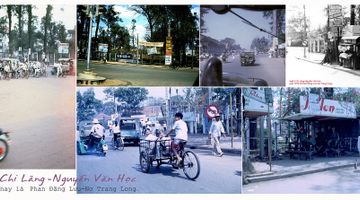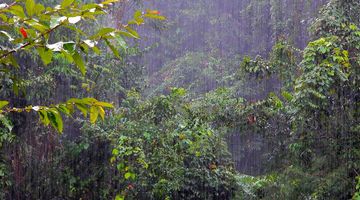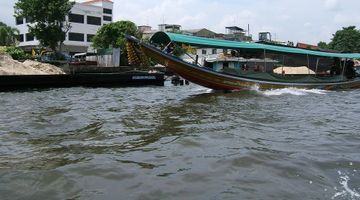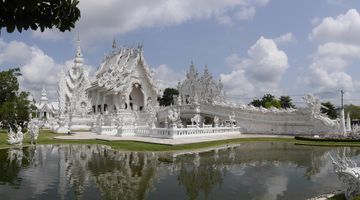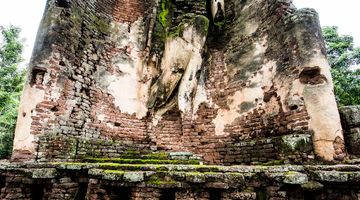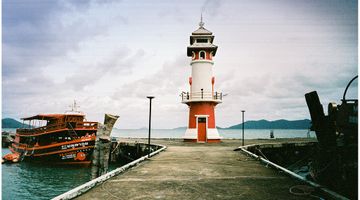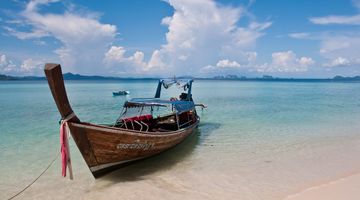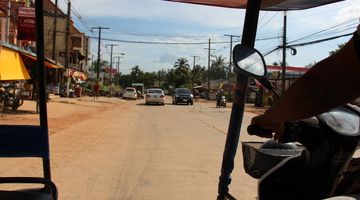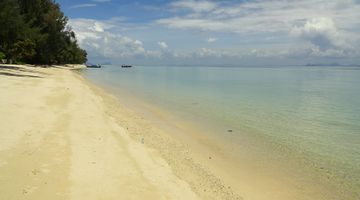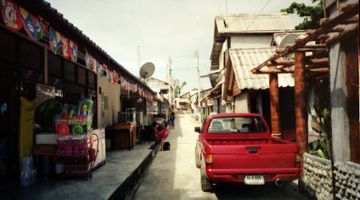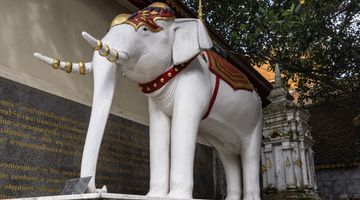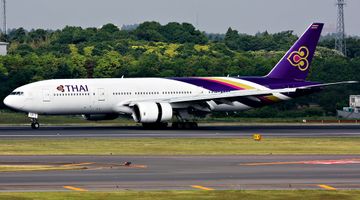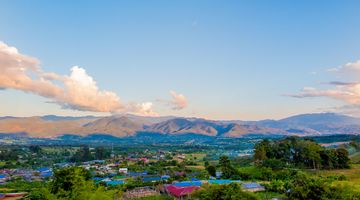Transport in Thailand – How to Get to and from and Travel Around the Country
Surrounded by the Andaman Sea, Indian Ocean and Gulf of Thailand and bordering with Myanmar, Laos, Cambodia and Malaysia, Thailand is located in both the eastern and northern hemispheres. The tropical country is also situated in Southeast Asia and identified as being a part of the Asian continent. While transport throughout the country of Thailand is diverse and largely tumultuous, the bustling capital of Bangkok is one of the busiest air transport hubs in the whole of Asia. While entering the country via air is a straightforward and simple affair, commuting around Thailand itself takes place via bus, minivan, train, ferry, longtail boat, tuk-tuk, songthaew, motorbike, scooter, bicycle and even via elephant in the very rural Thai countryside.
How to get to Thailand
By air
Getting into Thailand via plane is generally a stress-free endeavour with plenty of international and domestic flights taking place each hour throughout the country. Bangkok’s newer Suvarnabhumi Airport and older, Don Mueang International Airport are naturally the busiest (and often cheapest) of the lot; with Phuket, Hat Yai, Chiang Mai and Chiang Rai international airports getting their fair share of global travellers and visitors. Although most international airlines fly to Thailand, Thailand’s main international airlines are Thai Airways International, Thai Smile Airways, and Bangkok Airways.
The most affordable way to get into Thailand from Europe, Australia, South Africa and North America is to generally fly to Bangkok and then take another domestic flight to the city of your choice. There are however direct flights with several airlines, such as getting to Phuket from Singapore or Hong Kong is possible with Bangkok Airways; and from Kuala Lumpur with Berjaya Airlines and Firefly. Getting into Chiang Mai from Singapore is done via Silk Air, from Kuala Lumpur and Macau via Air Asia, and from Seoul via Korea Airlines.
By bus
For long distance travel not done via aeroplane, bus transport overshadows ferries and trains. Getting to and from Thailand via bus is possible from or to Laos, Cambodia, Malaysia and Myanmar and bus travel in Thailand proves to be the most affordable means of international travel. Tickets can be purchased at bus stations, online, through travel agents and occasionally through hotels or accommodations.
For example, there are several overnight or day bus companies that connect several Thai provinces/towns to Laos (and vice versa). Currently cities in Thailand that are connect to Laos, are Bangkok, Chiang Mai, Chiang Rai, Loei, Khon Khaen, Nong Khai, Nakon Phanom, Mukdahan, Udon Thani, and Ubon Ratchathani. Whereas provinces and towns in Laos that connect to Thailand are Bokeo, Luang Prabang, Vang Vieng, Vientiane Capital, Thakaek, Savannakhet, and Pakse.
By ferry
There is a regular ferry service between Thailand and Malaysia connecting several destinations in the Andaman Sea, primarily Koh Lipe, to Pulau Langkawi in Malaysia.
By train
Currently you can get to Thailand by train from Malaysia though technically you will need to change trains at the border town of Padang Besar. The international express train from Bangkok to Butterworth does not ply the route any more.
There is also a shuttle train between Nong Khai in Thailand and Laos but generally speaking it is just a means of crossing the border.
How to get around the country
Thankfully Thailand has a far-reaching and varied transport system within the country itself; making it easy, simple and affordable to explore and travel around. From the many domestic airlines, a decent railway network, government-owned and privately owned bus companies, an enormous and thriving minivan network, and plenty of ferry companies journeying to and from the many popular islands; locals and travellers will find touring the nooks and crannies of the country a simple affair.
By air
With numerous domestic airports and domestic flight companies to choose from, travellers will relish the luxury of affordable choice here in Thailand when looking to travel via plane. Other than the international airports already mentioned above, domestic airports in the kingdom include Lampang, Mae Hong Son, Mae Sot, Nan, Pai, Phitsanulok, and Sukhothai in the north; Chumpon, Nakhon Si Thammarat, Narathiwat, Ranong and Trang in the south; Khon Kaen, Loei, Nakhon Phanom, Ubon Ratchathani and Udon Thani in the northeast; and Trat and Pattaya in the east.
Domestic flight companies to book your flights through include, Thai Airways, Bangkok Airways, AirAsia, Scoot, Thai Smile, Thai Lion Air and Nok Air.
The three most popular low-cost airlines, AirAsia, Thai Lion Air and Nok Air, all announce seat sales which often allow you to grab tickets for as low as THB600, all-in. The same companies have special fly-and-ride or fly-and-ferry deals which make the process of getting to some of the Thai islands an easy and smooth one.
By train
Charmingly rustic, best describes Thailand’s train network which runs from Chiang Mai in the north, down through the capital of Bangkok and further south through Hat Yai, Surat Thani and all the way to the Thai-Malaysian border.
Additionally, from Bangkok there is a train line reaching Kanchanaburi in the west as well as two significant lines running to the east; one of which is Nong Khai (ideal for entering Laos via Vientiane) and the second, reaching Ubon Ratchathani (ideal for entering Laos from Pakse).
Passengers have the option of travelling in a range of comfort options, from third, second and first class carriages. Ultimately your budget will determine the softness of your chair, air-con possibilities or fan cooling. Regardless of which class you opt for, the journey will be slow.
Although the trains in Thailand can get you safely to many top destinations within the country, you will not get there in any kind of hurry. Be patient, take a book along and practice your Thai with the friendly locals.
Tickets for overnight trains should be bought at least a day in advance and even earlier during peak seasons or holidays. This is especially true of the more popular routes from the capital and vice versa, such as Bangkok to Chiang Mai, Bangkok to Chumphon, and Bangkok to Surat Thani.
By bus and minivan
The bus and minivan network in Thailand is extensive and widespread and while not known for their exceptional safety, the journeys are extremely affordable, reliable and frequent. Bus tickets and minivan tickets can be purchased at bus stations, online, via travel agents and also often at accommodations in the various cities. All provincial capitals have a minimum of one dedicated bus station that is often in an out-of-the-way location to assist with traffic flow.
Grabbing a local tuk-tuk or taxi may be necessary to get to the bus station.
Bus tickets will vary in price according to various comfort and luxury options. Fan-cooled buses are naturally less expensive than air-con buses but even with air-con buses classes range from standard through to VIP24. VIP24 buses have bigger seats that recline further, more leg space, increased luggage allowance, Wi-Fi, television and USB plug points to name a few offered amenities. A Bangkok–Chiang Mai VIP24 ticket should cost around THB1200 while an express bus for the same route can be bought at THB600.
While it is possible for travellers in bigger groups to hire a private minivan, minivans do not always guarantee passengers the best mode of transportation while in Thailand. Although minivan journeys are affordable and fast (e.g. between THB150 and THB200 for a distance of 150-200 km), they have a high rate of road accidents, are frequently overloaded and allow for very little luggage. Popular minivan routes are out of Bangkok, to and from various provinces in the south, and the famous and well-frequented Chiang Mai to Pai route.
By water (ferries, long-tail boats, speed boats)
Cheerful ferry operators are here in abundance on the islands of sunny Thailand and they are only too eager to transport travellers to and from the various islands or back towards the mainland.
Common ferry routes are from Phuket to Koh Phi Phi, Phuket to Krabi, Koh Samui to Koh Phangan, and to and from Surat Thani and Koh Samui or Koh Phangan.
Aside from the sea, Thailand is also home to navigable rivers, such as the Chao Phraya River in Bangkok and the Mae Khong River (Mekong) of which ferries, water taxis and long-tail boats are used as common means of transportation.
Speed boats are also available in Thailand and ply much of the same routes as the island-hopping ferries. Although speedboats are faster, they are not a safe means of transport while in Thailand and are often better avoided due to their high accident rates and frequent overloading.
How to get around cities/towns within the country
Specific local means of transport (tuk-tuks, songthaews, motorbike taxis)
Thailand is home to a colourful and diverse selection of transport options, most popular and unique being, tuk-tuks, songthaews and motorbike taxis.
Tuk-tuks (also known as rickshaws) are three-wheel motorised vehicles that are most commonly used as taxis. With their gaudy flashing lights, pumping stereos and bright paint work, tuk-tuks are often enjoyed by foreigners for their novelty and it is not uncommon to see these cheerful vehicles all over the more touristy parts of the country. These vehicles are only ever used for short distances and should never cost more than a metered taxi for the same distance, although you can bet your bottom dollar on the fact that tuk-tuk drivers will try.
Songthaews are a significant player in Thailand’s transport system, and are essentially a converted pickup truck generally used to transport bigger groups of people. Some have a roof, others don’t, and generally they have two parallel bench-like seats installed on the back of the truck. In Thailand songthaews mostly run set routes, with a determined start and end point, and usually have standard fares. Used for both inner-city and provincial travel, songthaews are occasionally the sole option for traveling along some routes. Popular songthaew routes include Chiang Rai to Mae Salong and Mae Sot to Umphang.
Exactly as the name suggests, motorbike taxis are taxi drivers with bright coloured vests who will transport you over a short distance on the back of their motorbike. Fast, affordable and a favourite means of ‘public’ transport with the locals, motorbike taxis are not for the faint-hearted. Keep your knees tucked in, hold on tight and always insist on a helmet.
Local buses and trains
Local buses and trains are more popular and developed in Bangkok than in other parts of the country and the capital has an extensive bus network that offers local transit services to locals and foreigners. The Bangkok Mass Transit Authority (BMTA) operated something of a monopoly, although in recent years the BRT has been proven to be a huge hit with commuters in Bangkok. Reliable, affordable and safe, the BRT is an excellent means of travelling around the capital.
Train options for those in Bangkok are either, the BTS Skytrain, the MRT and the Airport Rail Link. The BTS Skytrain is made of two lines: Sukhumvit and Silom, consisting of thirty stations along 31 kilometres. The MRT is also made up of two lines, the Blue Line and the Purple Line with 35 stations along 42 kilometres. Lastly, the Airport Rail Link connects the city centre to Suvarnabhumi Airport and is an affordable and reliable means of transportation for those needing a ride to or from the airport.
Rental options
For travellers who long for the freedom of independent travel, hiring a motorbike or scooter while in Thailand is an easy and fun way to explore the country without having to hail down taxis or wait for buses or songthaews. Motorbikes or scooters can be rented for around THB200-300 a day from pretty much any city within Thailand. Cheap, easy to find and fun, this is a great option for experienced and licensed drivers.
Although thousands of tourists that visit Thailand each year hire motorbikes without a valid license, this does not mean that it is legal. All too often visitors in Thailand can be seen driving their rented vehicle around the streets shirtless, helmet-less and haphazardly. Motorbike accidents in Thailand are the biggest danger that travellers face. The road rules and traffic signs in Thailand are chaotic, disorganised and largely overwhelming for visitors and renting a motorbike should not be taken lightly. For those who are responsible, qualified and skilled, this is an excellent means of discovering hidden gems and getting wonderfully lost off the beaten track.






